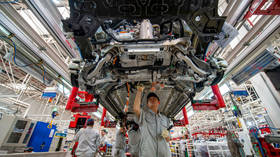US army non-hostile deaths in Iraq exceed combat
As the U.S. prepares to pull its troops out of Iraqi cities next month, American soldiers are still being killed in Iraq - but not in action.
The Pentagon says in the last few months, more troop members died in often preventable, non-hostile incidents, than in combat.
These incidents are accidents such as vehicle and helicopter crashes, illnesses, as well as accidental shootings, and are the now number one killer in Iraq. This is the case for the first time since the war began.
Compared to other conflicts, the US Army's share of nonbattle casualties is at a record high. A whole 20%, or 1 in 5, of all American servicemen deaths in Iraq are the result of nonbattle losses. In the Afghanistan campaign, this share is as high as 50%, although fewer troops were actually engaged in the conflict.
The main problem remains the lack of preparation, and as a result, all those men and women are suffering deaths that really could have been prevented.
Another factor is that many soldiers are serving on multiple tours and the fatigue is starting to take hold.
All this indicates that the troops are really worn out and sometimes are not effectively trained.
Suicides are also a cause of these non-hostile deaths.
At the same time, compared with other wars, the overall death toll in Iraq is considerably smaller.
In 2009, there have been 72 US military deaths in Iraq because of the accidents and illnesses, and only 67 in combat. Altogether, that makes a much smaller number than those who used to die in previous wars, such as Vietnam, for example.
However, this cannot serve as an excuse for the troops not being prepared, and the US army is going to take a lot of flak for this once the relatives of the dead realize that their loved ones died just because they were not trained properly.
Now it looks as though the military security officials are going to work hand in hand with the commanders of each and every unit to teach them the tactics of survival.
For whom the bell tolls
Comment by the RT military analyst Colonel Eugene Khrushchev
There are several reasons why the non-combat death toll outstrips KIA number in Iraq & Afghanistan, but ‘the lack of preparation’ is definitely not ‘the main problem’.
Background
In fact, US GIs are the best trained in the world, no question about it (as the first Soviet officer to be a guest speaker at Fort Brag JFK Special Warfare school in 1990, I’ve been in touch with American vets since then as a Russian officer.)
The question is: The US military is ‘the best trained’ for what? For starters, there are two types of US forces:
The bulk of the forces have been trained for conventional war, zeroing in on heavy-impact, short-term, high tempo blitzkrieg. Last time I checked, it was perfectly executed by General Schwarzkopf in Desert Storm.
Only Special Operations Forces, the cream of the crop, are trained for the post-Cold War challenge of asymmetrical war.
Generic military & Special Forces guys are worlds apart: they have totally divergent skill sets and problems.
The root of the problem
There is no such a thing as a conventional war in Iraq & Afghanistan.
Urban insurgency in one place and rural insurgency in another are just 2 distinct types of low-intensity conflicts which, together with special & stability ops, are part and parcel of asymmetrical war.
The main problem for the US Army in Afghanistan & Iraq is that the conventional forces, for all intent and purpose, cannot effectively cope with unconventional challenges.
For US generic grunts, it’s the psychological torture of the lost self-identity. Camouflaged as post-traumatic stress disorder, it results in dereliction of duty, alcohol & drug abuse, and a trigger-happy and reckless modus operandi.
The synergy of all those negative factors eventually leads to an abnormal spike in the non-combat attrition rate – when a subliminal search for suicide supersedes the sense of mission.
As for the Special Forces worries, it’s a totally different story…












